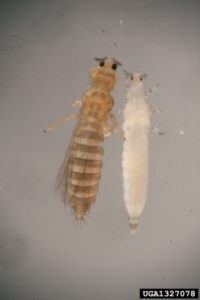Time to Check Cotton for Thrips
go.ncsu.edu/readext?464949
en Español / em Português
El inglés es el idioma de control de esta página. En la medida en que haya algún conflicto entre la traducción al inglés y la traducción, el inglés prevalece.
Al hacer clic en el enlace de traducción se activa un servicio de traducción gratuito para convertir la página al español. Al igual que con cualquier traducción por Internet, la conversión no es sensible al contexto y puede que no traduzca el texto en su significado original. NC State Extension no garantiza la exactitud del texto traducido. Por favor, tenga en cuenta que algunas aplicaciones y/o servicios pueden no funcionar como se espera cuando se traducen.
Português
Inglês é o idioma de controle desta página. Na medida que haja algum conflito entre o texto original em Inglês e a tradução, o Inglês prevalece.
Ao clicar no link de tradução, um serviço gratuito de tradução será ativado para converter a página para o Português. Como em qualquer tradução pela internet, a conversão não é sensivel ao contexto e pode não ocorrer a tradução para o significado orginal. O serviço de Extensão da Carolina do Norte (NC State Extension) não garante a exatidão do texto traduzido. Por favor, observe que algumas funções ou serviços podem não funcionar como esperado após a tradução.
English
English is the controlling language of this page. To the extent there is any conflict between the English text and the translation, English controls.
Clicking on the translation link activates a free translation service to convert the page to Spanish. As with any Internet translation, the conversion is not context-sensitive and may not translate the text to its original meaning. NC State Extension does not guarantee the accuracy of the translated text. Please note that some applications and/or services may not function as expected when translated.
Collapse ▲This is just a reminder to check cotton for thrips. It’s a hard reminder when there is so much to be done, but early sprays are worth more. Don’t forget thrips injury is a function of plant growth and thrips dispersal. A slow growing plant and lots of thrips can mean lots of injury. Right now, even though growing conditions are improving, thrips are dispersing off maturing winter weeds and wheat into cotton.
The new thrips forecasting tool predicted that cotton planted during the first two weeks of May will be very susceptible to thrips injury (see this article for more details on this tool). We also have solid research demonstrating that early sprays for thrips (at, or just before, the one leaf stage) give you the most bang for your buck. This is because the adults migrate to fields and lay eggs in cotyledons. So if you see immatures on your plant (see photo), it means that those eggs have hatched and your seed treatment or in-furrow could be breaking. Our threshold to spray is two immature thrips per plant, with injury present on 25% of the plants.



